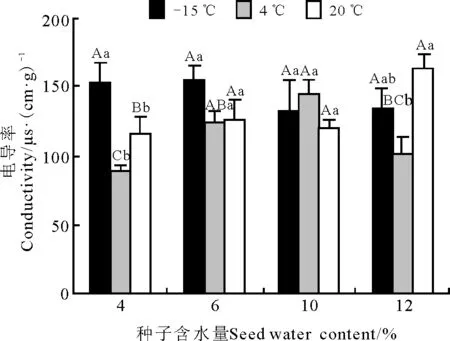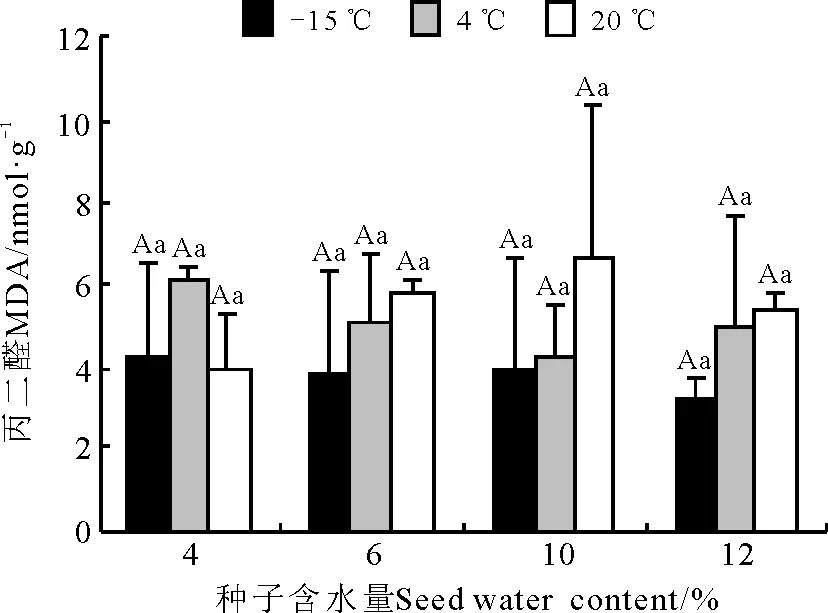贮藏温度和种子含水量对扁穗冰草种子质量的影响
2016-12-09刘鸿飞杨合龙戎郁萍
杨 晗,刘鸿飞,杨合龙,戎郁萍
(北京市草业科学重点实验室,中国农业大学动物科技学院,北京 100193)
贮藏温度和种子含水量对扁穗冰草种子质量的影响
杨 晗,刘鸿飞,杨合龙,戎郁萍
(北京市草业科学重点实验室,中国农业大学动物科技学院,北京 100193)
以扁穗冰草(Agropyroncristatum)种子为试验材料,研究不同温度和含水量贮藏10个月后对种子发芽率和萌发过程中生理生化变化的影响。结果表明,贮藏温度和种子含水量对发芽率、根长和芽长均具有极显著影响(P<0.01),而对丙二醛含量影响均不显著(P>0.05)。扁穗冰草种子在-15 ℃且含水量为6%的条件下发芽率最高,为79.8%,在室温(20 ℃)且种子含水量为12%时,发芽率为0。扁穗冰草种子在4 ℃且含水量为6%的条件下胚根最长;在-15 ℃且含水量为12%的条件下胚芽最长。贮藏温度在20 ℃条件下,含水量为6%和12%的种子胚根、胚芽分别表现为最短和没有发芽。扁穗冰草种子在20 ℃且含水量为12%的条件下电导率最大;在4 ℃且含水量为4%的条件下电导率最小。相关分析表明,胚根与胚芽极显著正相关(P<0.01),与电导率显著正相关(P<0.05),其它各指标间均不显著相关(P>0.05)。综合各项活力指标,扁穗冰草种子的适宜贮藏含水量为4%~6%,最佳贮藏温度为-15~4 ℃。
扁穗冰草;贮藏温度;种子含水量;种子活力
扁穗冰草(Agropyroncristatum)是多年生禾本科植物,具有很高的饲用价值和经济利用价值[1],其茎叶柔嫩、营养丰富、适口性好、抗旱性强,是我国干旱半干旱地区用于建植栽培草地、补播天然草地和恢复退化草地的一种优良牧草[2]。植物种子在贮藏过程中常发生劣变,使种子发芽率降低、出苗不整齐,幼苗抗性降低,因此研究牧草种子的适宜贮藏条件,是提高牧草种用价值的关键。
种子贮藏主要受贮藏温度和种子含水量的影响。我国对一些重要牧草已开展了抗性生理、种子生理、细胞遗传等方面的研究,集中于种质遗传稳定性、种质劣变、损伤机理以及种子抗逆性等。研究发现,种子的发芽率、发芽势和发芽指数随着贮藏时间的延长都呈下降趋势[1,3]。不同贮藏年限的蒙农杂种冰草(A.cristatum×A.desertorumcv. Hycrest Mengnong)种子有不同程度的休眠和生活力下降现象,其中贮藏1~2年的种子休眠性最强,贮藏4年的种子发芽率最高[4]。碟果虫实(Corispermumpatelliforme)在5种储藏方式下种子的生活力没有改变,冷干藏是较为理想的种子储藏方式[5]。较多研究发现,贮藏温度和种子含水量均能影响种子活力,随着贮藏时期的延长,种子的活力呈下降趋势,低贮藏温度和低含水量能较好地保持种子活力[6-8]。McDonald[9]总结前人的研究后认为,种子含水量和温度是影响种子在贮藏期间活力重要因素。本研究通过测定不同贮藏条件下扁穗冰草种子的萌发特性(发芽率、根长、芽长),种子浸出液电导率及丙二醛含量,分析贮藏条件对扁穗冰草种子萌发、种子质膜以及生理生化性质的影响,阐明影响牧草种子劣变的主要原因,旨为延长种子寿命和保持种子活力提供指导。
1 材料与方法
1.1 试验材料
试验材料是中国农业科学院畜牧研究所在山西太原种子扩繁基地扩繁的由俄罗斯种质库引进的扁穗冰草。于2009年开始扩繁种植,2012年秋季收获种子,种子处理后低温(5~10 ℃)避光保存至2013年春季开始试验处理。处理前种子的基本情况:批次为ZXY09P-6054,千粒重为2.12 g,初始含水量为9.77%,初始发芽率为98%。
1.2 试验方法
种子千粒重测定:按照国际种子检验规程,测定种子千粒重[10]。
种子最初含水量测定:根据国际种子检验规程规定测定种子最初含水量[11]。
最初含水量=(M2-M3)/(M2-M1)×100%。
式中:M1为铝盒及盒盖重量(g);M2为铝盒和盖及样品烘干前重量(g);M3为铝盒和盖及样品烘干后重量(g)。
种子最终含水量测定:通过下列公式[12]计算。
最终含水量=100%-最初重量×(100%-最初含水量)/最后重量。
计算达到最终含水量为4%、6%、10%和12%时的最后重量,通过置于含有变色硅胶的干燥器内定期测定重量,获得低于种子最初状态的含水量种子(4%和6%);通过将种子放在相对湿度为70%~80%,温度在25 ℃的环境条件下,经常搅动种子,定期测定重量,获得高于种子最初状态的含水量种子(10%和12%)。
将含水量为4%、6%、10%和12%的扁穗冰草种子用铝袋密封包装分别贮藏在-15、4和20 ℃条件下贮藏10个月(2013年6月-2014年3月)备用。
1.3 指标测定方法
种子发芽率测定:根据国际种子检验规程测定[10]。采取纸上发芽,每个培养皿放置100粒种子,重复4次,5 ℃下预冷7 d后移入发芽箱,扁穗冰草每天光照8 h/温度20 ℃与黑暗16 h/温度30 ℃,发芽率按14 d计。
发芽率=(发芽试验期间种子全部正常发芽数/供试种子数)×100%
种子胚根长、胚芽长测定:在发芽试验结束的第14天,对扁穗冰草的胚根长和胚芽长进行测量。
种子电导率测定:参照参考文献[13],取种子50粒称重,3次重复。用去离子水洗3次,吸干表面浮水后,置于100 mL的三角瓶中,以未处理种子为对照。加去离子水30 mL,加盖后在20 ℃恒温培养箱中放置24 h,用FE30电导率仪测定浸出液的电导率。
种子中丙二醛(MDA)含量测定:采用硫代巴比妥酸法测定[14],用紫外可见光分光光度计在600 nm和532 nm波长下测定反应液的吸光值,计算丙二醛的含量(nmol·g-1)。
MDA含量(nmol·g-1)=[6.45(A532-A600)-0.56A450]×A×V/a/W。
式中:A为反应液体积;V为提取液总量;a为测定用提取液量;W为植物组织重量。
1.4 数据处理与统计分析
使用Microsoft Excel 2003对数据进行预处理,采用SPSS 17.0对所测数据统计分析,采用双因素方差分析对种子贮藏温度、种子含水量及其可能的交互作用进行分析(ANOVA),并对发芽率与其它各指标的关系进行相关性分析(Person)。
2 结果与分析
2.1 不同贮藏条件对扁穗冰草种子主效应和交互作用分析
贮藏温度、种子含水量及其互作对扁穗冰草种子的发芽率、胚根长和胚芽长均具有极显著影响(P<0.01)。贮藏温度及温度和含水量的互作对电导率有极显著影响(P<0.01)。而贮藏温度和含水量对种子丙二醛含量的影响均不显著(表1)。

表1 贮藏温度和种子含水量的主效应和交互作用分析Table 1 The analysis of main effects and interactions between storage temperature and seed water content
注:**表示差异极显著 (P<0.01),ns表示差异不显著。
Note: ** indicate significant difference at 0.01 level, ns indicate no significant difference.
2.2 不同贮藏条件对扁穗冰草种子发芽率的影响
同一含水量不同温度条件下,均表现为随贮藏温度的升高发芽率降低;含水量为12%的种子20 ℃贮藏后的发芽率为0(图1);相同含水量不同温度条件下,-15 ℃的发芽率显著高于20 ℃处理的(P<0.05),而与4 ℃之间差异不显著(P>0.05)。相同温度不同含水量条件下,贮藏温度为-15 ℃和4 ℃时,种子发芽率在4个不同含水量下无显著差异(P>0.05)。20 ℃时,4个含水量下种子的发芽率均差异显著(P<0.05),6%含水量的发芽率最高。以上结果表明,扁穗冰草种子在-15 ℃条件含水量为6%时的发芽率最高,低温和低含水量条件有利于保持种子的高生活力。

图1 种子含水量和贮藏温度对扁穗冰草种子发芽率的影响Fig. 1 Effect of seed water content and storage temperature on the seed germination percentage of Agropyron cristatum
注:不同大写字母表示在相同温度下不同种子含水量间差异显著(P<0.05);不同小写字母表示相同种子含水量不同温度间差异显著(P<0.05)。下同。
Note: Different capital letters under the same storage temperature indicate significant difference under different seed water content at 0.05 level; Different lower case letters for the same seed water content indicate significant differences under different storage temperature at 0.05 level. The same below.
2.3 不同贮藏条件对扁穗冰草种子胚根长、胚芽长的影响
扁穗冰草胚根长集中在6~7 cm,没有明显规律。胚芽长集中在8 cm左右,表现出贮藏温度越高、芽长越小的规律(图2和图3)。相同含水量不同温度条件下,含水量12%的种子20 ℃贮藏后没有发芽,含水量为6%的种子在20 ℃贮藏后,种子胚根长、胚芽长显著低于其它两个温度(P<0.05)。相同温度不同含水量条件下,贮藏温度20 ℃时,含水量为4%和6%之间的胚根、胚芽长差异显著(P<0.05),但与含水量为10%的差异不显著(P>0.05)。贮藏温度为-15 ℃和4 ℃种子在各含水量间差异不显著(P>0.05)。这表明,低温低含水量有利于扁穗冰草种子胚根、胚芽生长。
2.4 不同贮藏条件对扁穗冰草种子电导率的影响
温度和含水量对电导率的影响没有明显规律(图4)。种子含水量为12%时,20 ℃下种子浸出液电导率最大。种子含水量为4%时,4 ℃下种子浸出液电导率最小。在相同含水量不同温度条件下,含水量为6%Agropyroncristatum
和10%的种子在不同温度贮藏后浸出液电导率均无显著差异(P>0.05)。含水量为4%的种子在-15 ℃条件下贮藏后的电导率显著高于4 ℃的(P<0.05)。而含水量为12%时,20 ℃条件下贮藏后种子的浸出液电导率显著高于4 ℃(P<0.05)。种子在相同温度不同含水量条件下,贮藏温度为-15 ℃时,4个含水量之间种子浸出液电导率均无显著差异(P>0.05)。4 ℃贮藏条件下,含水量为10%时的电导率显著高于4%时的电导率(P<0.05)。20 ℃贮藏条件下,含水量为12%时的电导率显著高于4%时的电导率(P<0.05)。以上结果表明,低温低含水量条件下的扁穗冰草种子浸出液的电导率较低,说明种子原生质膜的结构和功能受到破坏的程度小,种子活力高。

图2 种子含水量和贮藏温度对扁穗冰草根长的影响Fig.2 Effect of seed water content and storage temperature on the root length of Agropyron cristatum

图3 种子含水量和贮藏温度对扁穗冰草芽长的影响Fig.3 Effect of seed water content and storage temperature on the bud length of Agropyron cristatum

图4 种子含水量和贮藏温度对扁穗冰草种子电导率的影响Fig.4 Effect of seed water content and storage temperature on the conductivity of
2.5 不同贮藏条件对扁穗冰草种子丙二醛(MDA)含量的影响
种子含水量在6%、10%和12%时,MDA随贮藏温度的增加呈上升趋势;而含水量在4%时,随贮藏温度的增加呈现先增加后减少的趋势(图5)。相同含水量不同温度和相同温度不同含水量条件下,MDA含量差异均不显著(P>0.05)。以上结果表明,含水量为12%的种子在-15℃下MDA的含量最少。在此条件下贮藏对防止种子中脂质过氧化作用的加深最有效果,即最有利于防止贮藏过程中种子的老化。

图5 种子含水量和贮藏温度对扁穗冰草种子丙二醛的影响Fig.5 Effect of seed water content and storage temperature on MDA of Agropyron cristatum
2.6 种子各活力指标的相关关系
对扁穗冰草种子各指标进行相关性分析发现,胚根长与胚芽长极显著正相关(P<0.01),扁穗冰草胚根长与电导率显著正相关(P<0.05)。发芽率和电导率呈负相关关系(P>0.05),丙二醛与胚芽长、电导率呈负相关关系,其它各指标间相关不显著(P>0.05)(表2)。

表2 扁穗冰草种子各指标相关关系Table 2 The correlation between different indexes of Agropyron cristatum
注:**表示极显著相关;*表示显著相关。
Note:**and * show significant correlation at 0.01 and 0.05 level, respectively.
3 讨论
种子在贮藏过程中受很多因素影响,种子含水量、贮藏温度和贮藏时间对种子寿命和种子活力的影响较为显著[15]。相关研究表明[16-18],水分对种子劣变的作用远大于温度。种子劣变期间,质膜受损是主要的生理变化之一[19-20],种子生活力和发芽率下降,膜系统功能异常、透性增大、电导率上升[21-23]。黑紫披碱草(Elymusatratus)和老芒麦(E.sibiricus)在高温(45 ℃)、高湿(相对湿度100%)的人工老化方法处理后,种子的发芽率随老化时间的延长而降低[24]。还有研究[40]发现,低含水量低贮藏温度的种子发芽率相对较高。在对冰草属牧草耐贮藏性[25]的研究中发现,室温条件下贮藏,其种子寿命较长,属耐贮藏草种。贮藏温度对种子的耐藏性影响最大[26]。而在短期内,降低种子含水量较降低温度对种子寿命影响更明显[27]。Ackigoz和Knowles[28]发现在贮藏前对种子进行干燥处理并不会延长种子寿命。在本研究中,贮藏温度、种子含水量对扁穗冰草的发芽率、胚根长和胚芽长均具有显著影响(P<0.05)。扁穗冰草种子在-15 ℃且含水量为6%的条件下发芽率最高,种子在4 ℃且含水量为6%的条件下根长最长,在-15 ℃且含水量为12%的条件下芽长最长。这说明种子的活力指标受温度和含水量的交互作用影响,且对不同指标的作用不同;在给定的温度条件下,并非种子含水量越低越有利于种子保存,种子安全含水量存在下限,超过下限会导致种子损伤,并且会使种子的耐藏性下降。在考虑种子贮藏的最适宜条件时,应综合各指标进行判断。
电导率测定提供了一个间接评定质膜受损程度的方法[29],在许多冰草种子活力的研究中,电导率被用作测定种子活力的鉴定方法[30-32]。丙二醛是脂质过氧化作用的终产物,可以表明种子的生物膜受到毒害严重程度。有些研究[7,33]发现,种子活力与电导率呈现负相关关系,而有些研究[17,33-39]发现,电导率与生活力不相关或与种子劣变程度的相关不显著。有研究[40-41]指出,劣变种子表现在丙二醛含量升高,但Linn和Pearce[42]研究发现脂质过氧化作用对膜结构的解体没有起作用。在本研究中,贮藏温度及温度和含水量的互作对冰草种子的电导率有显著影响(P<0.05),但对丙二醛均未达显著水平。含水量为4%的种子,在-15 ℃条件下的电导率显著高于4 ℃的(P<0.05)。含水量为12%的种子,在20 ℃下的电导率显著高于4 ℃下的(P<0.05)。4 ℃贮藏条件下,含水量为10%时的电导率显著高于4%时的电导率(P<0.05)。20 ℃贮藏条件下,含水量为12%时的电导率显著高于4%时的电导率(P<0.05)。综合方差分析与多重比较,低温低含水量下的种子电导率相对较小,种子膜破坏程度较小,有利于保持种子的高活力。相关性分析发现,发芽率与电导率呈负相关关系,这正体现了低温与低含水量贮藏条件下,种子原生质膜的结构和功能受到破坏的程度小,形成了相对较高的发芽率以及相对较低的电导率。扁穗冰草种子的丙二醛含量集中在4~7 nmol·g-1,且各处理间均差异不显著,因此本研究认为丙二醛不能作为预测扁穗冰草种子质量的指标。
4 结论
通过各项指标分析,低含水量和低温贮藏能有效保持扁穗冰草种子的活力,延缓种子内部生理生化特性变化。在本研究中,扁穗冰草种子最适的贮藏含水量为4%~6%,最佳贮藏温度为-15~4 ℃。各处理间的扁穗冰草种子丙二醛含量差异不显著,所以不能作为测量种子活力的指标。
References:
[1] 王方.扁穗冰草属植物种质资源遗传多样性研究.兰州:兰州大学研究生学位论文,2009.
Wang F.Study on genetie diversity ofAgropyrongaertngermplasm resources.Master Thesis.Lanzhou:Lanzhou University,2009.(in Chinese)
[2] 高海娟,云锦凤,刘德福.荒漠草原地区3种扁穗冰草种子萌发的研究.草业科学,2007,24(5):64-68.
Gao H J,Yun J F,Liu D F.Study on seed germination of three wheatgrass species in desert steppe.Pratacultural Science,2007,24(5):64-68. (in Chinese)
[3] 程钰宏,杜丽霞,赵瑞雪,董宽虎.新麦草种子贮藏第一年的生活力变化.草业与畜牧,2009,28(5):13-16.
Cheng Y H,Du L X,Zhao R X,Dong K H.The vitality changes of Russian wildrye seeds in the first year.Caoye Yu Xumu,2009,28(5):13-16.(in Chinese)
[4] 董玉林,云锦凤,石凤翔,高翠萍.不同贮藏年限蒙农杂种冰草种子生活力及活力的变化.内蒙古草业,2007,19(3):1-4.
[5] 刘有军,纪永福,李得禄.储藏方式对碟果虫实种子萌发和幼苗生长的影响.草业科学,2014,31(10):1908-1914.
Liu Y J,Ji Y F,Li D L.Effects of different storage methods on germination and seedling growth ofCorispermumpatelliformeseeds.Pratacultural Science,2014,31(10):1908-1914.(in Chinese)
[6] 韩玉竹,伍莲,曾兵,王维,程亮旗.贮藏温度和种子含水量对高羊茅种子活力的影响.种子,2011,30(6):41-44.
Han Y Z,Wu L,Zeng B,Wang W,Cheng L Q.Effects of storage temperature and seed moisture content on seed vigor of tall fescue.Seed,2011,30(6):41-44.(in Chinese)
[7] 张凤,刘美,杨翠翠,杨文思,孙庆泉.贮藏温度和种子含水量对大豆种子活力的影响.山东农业科学,2014,46(8):37-41.
Zhang F,Liu M,Yang C C,Yang W S,Sun Q Q.Effects of storage temperature and seed moisture content on soybean seed vigor.Shandong Agricultural Sciences,2014,46(8):37-41.(in Chinese)
[8] 朱萍,孔令琪,李高,张晓媛,于晓娜,毛培胜.贮藏温度对不同含水量老芒麦生理特性影响.草业学报,2011,20(6):101-108.
Zhu P,Kong L Q,Li G,Zhang X Y,Yu X N,Mao P S.Effect of moisture content on physiological characteristics ofElymussibiricusseed under different storge temperature conditions.Acta Pratacultuurae Sinica,2011,20(6):101-108. (in Chinese)
[9] McDonald M B.Seed deterioration:Physiology,repair and assessment.Seed Science and Technology,1999,27(1):177-237.
[10] International Seed Testing Association (ISTA).International Rules for Seed Testing.Seed Science and Technology,1999,27:27-32,174-182.
[11] 张云兰,陶梅,郭欣荣,辛萍萍.谷子、绿豆、豌豆和红小豆种子贮藏最适含水量研究.种子,2001(3):16-20.
Zhang Y L,Tao M,Guo X R,Xin P P.Study on optimal moisture contents for seed storage of millet,mung bean,pea and adzuki bean.Seed,2001(3):16-20.(in Chinese)
[12] 国际种子检验协会.国际种子检验规程(1976).颜启傅,毕辛华,译.北京:技术标准出版社,1980.
International Seed Testing Association.International Seed Testing Rules(1976).Traslation,Yan Q F,Bi X H.Beijing:Technical Standards of Press,1980.(in Chinese)
[13] 徐本美,韩建国.ISTA种苗评定与种子活力测定方法手册.北京:北京农业大学出版社,1993.
[14] 中国科学院上海植物生理研究所,上海植物生理学会.现代植物生理学试验指南.北京:科学出版社,1999:305-306.
Shanghai Institute of Plant Physiology,Shanghai Academy of Plant Physiology.Modern Plant Physiology Experiment Guide.Beijing:Science Press,1999:305-306.(in Chinese)
[15] Sun Q,Wang J H,Sun B Q.Advances on seed vigor physiological and genetic mechanisms.Agricultural Sciences in China,2007,6(9):1060-1066.
[16] Harrington J F.Thumb rules of drying seeds.Crops and Soils,1960,13:16-17.
[17] 付华,王彦荣,余玲.老化处理对几种牧草种子乙烯释放量的影响.草业学报,2001,10(1):64-70.
Fu H,Wang Y R,Yu L.Effect of aging treatment on seed ethylene production in several forage species.Acta Prataculturae Sinica,2001,10(1):64-70.(in Chinese)
[18] 王彦荣,余玲,刘友良,沈益新.数种牧草种子劣变的生活力与膜透性的关系.草业学报,2002,11(3):85-91.
Wang Y R,Yu L,Liu Y L,Shen Y X.Relationship between seed viability and membrane permeability during seed deterioration in several forage species.Acta Prataculturae Sinica,2002,11(3):85-91.(in Chinese)
[19] Basavarajappa B S,Shetty H S,Prakash H S.Membrane deterioration and other biochemical changes,associated with accelerated ageing of maize seeds.Seed Science and Technology,1991,19(2):279-286.
[20] Kalpana R,Madhava Rao K V.On the ageing mechanism in pigeonpea(Cajanuscajan(L.)Millsp) seeds.Seed Science and Technology,1995,23(1):1-9.
[21] Wang Y R,Hampton J G.Seed vigor and storage in grassland pawera red clover.Plant Varieties and Seeds,1991,4(2):61-66.
[22] 于卓,孙样,张红蕾,李造哲.柠条、花棒种子活力研究初报.中国草地,1990(6):65-68.
Yu Z,Sun Y,Zhang H L,Li Z Z.The research about seed vigor ofCaraganakorshinskiiandHedysarumscoparium.Grassland of China,1990(6):65-68.(in Chinese)
[23] 王彦荣,刘友良,沈益新.牧草种子活力检测技术述评.草业学报,2001,10(1):48-57.
Wang Y R,Liu Y L,Shen Y X.An evaluation of seed vigor tests for forage species.Acta Prataculturae Sinica,2001,10(1):48-57.(in Chinese)
[24] 邓庆元.冰草属牧草种子寿命与耐贮藏性研究.现代园艺,2013(1):6.
Deng Q Y.The research about longevity and storage resistance ofAgropyronforage seeds.Xiandai Horticulture,2013(1):6.(in Chinese)
[25] 吴浩,周青平,颜红波,梁国玲,刘文辉,魏小星,刘勇.人工老化对两种披碱草属种子生理生化特性的影响.草业科学,2014,31(12):2251-2256.
Wu H,Zhou Q P,Yan H B,Liang G L,Liu W H,Wei X X,Liu Y.Effects of accelerated aging on physiological and biochemical characteristics of twoElymusspecies seeds.Pratacultural Science,2014,31(12):2251-2256.(in Chinese)
[26] 朱昌兰,潘晓云,宋宇.不同贮藏条件对杂交稻种子耐藏性的影响.江西农业大学学报,1998,20(1):46-50.
Zhu C L,Pan X Y,Song Y.Effects of different storage conditions on storability of hybrid rice seeds.Acta Agriculturae Universitis Jiangxiensis,1998,20(1):46-50.(in Chinese)
[27] 陈志宏.三种牧草种子超干贮存生理生化特性及耐贮藏性机理研究.北京:中国农业科学院博士学位论文,2011.
Chen Z H.Studies on physiologicl-biochemical characteristics and mechanism of storability of three forage seeds during ultra-dry storage.PhD Thesis.Beijing:Chinese Academy of Agricultural Sciences,2011.(in Chinese)
[28] Ackigoz E,Knowles R P.Long-term storage of grass seeds.Canadian Journal of Plant Science,1983,63:669-674.
[29] Delouche J C,Baskin C C.Accelerated aging techniques for predicting the relative storability of seed lots.Seed Science and Technology,1973,1(2):427-452.
[30] Matthews S,Whitbread R.An association between seed exudation and the incidence of the pre-emergence mortality in wrinkle seeded peas.Phant Pathology,1968,17:11-17.
[31] 李玉荣.新麦草和蓝茎冰草种子的劣变与生理生化变化的研究.北京:中国农业大学硕士学位论文,2004.
Li Y R.Studies on seed deterioration and the physiological and biochemical of Russian wildrygrss and rosana western wheatgrass seeds.Master Thesis.Beijing:China Agriculture University,2004.(in Chinese)
[32] Hendricks S B,Taylorson R B.Variation in germination and amino acid leakage of seeds with temperature related membrane phase change.Plant Physiology,1976,58(1):7-11.
[33] 王勇,徐春波,韩磊.不同贮藏年限老芒麦种子活力研究.种子,2012,8(8):14-17.
Wang Y,Xu C B,Han L.Studies on seed vigor and physiological indicators of different storage durationElymussibiricusL.Seed,2012,8(8):14-17.(in Chinese)
[34] Ching T M.Schoolcraft I.Physiological and chemical differences in aged seed.Crop Science,1968,8:407-409.
[35] Bennett J S,Rowarth J S,Jin Q F.Seed nitrogen and potassium nitrate influence browntop (AgrostiscapillariesL.) and perennial ryegrass (LoliumperenneL.) seed performance.Journal of Applied Seed Production,1998,16:77-81.
[36] Cookson W R,Rowarth J S,Sedcole J R.Seed vigour in perennial ryegrass (LoliumperenneL.):Effect and cause.Seed Science and Technology,2001,29(1):55-270.
[37] Marshall A H,Naylor R E L.Seed vigour and field establishment in Italian ryegrass (LoliummultiflorumL.).Seed Science and Technology,1985,13:781-794.
[38] Hall R D,Wiesner L E.Relationship between seed vigor test and field performance of regar meadow bromegrass.Crop Science,1990,30(5):967-970.
[39] 李玉荣,韩建国,孙彦,任卫波,王小山.新麦草种子劣变过程中生理生化变化.草地学报,2005,13(3):180-183.
Li Y R,Han J G,Sun Y,Ren W B,Wang X S.Physiological and biochemical changes in russian wildryegrass seed during seed deterioration.Acta Agrestia Sinica,2005,13(3):180-183.(in Chinese)
[40] Goel A,Sheoran I S.Lipid peroxidation and peroxide scavenging enzymes in cotton seeds under natural ageing.Biologia Plantarum,2003,46(3):429-434.
[41] Sung J M,Chiu C C.Lipid peroxidation and peroxide scavenging enzymes of naturally aged soybean seed.Plant Science,1995,110(1):45-52.
[42] Lin S S,Pearce R S.Changes in lipids of bean seeds (Phaseolusvulgaris) and corn caryopses (Zeamays) aged in contrasting environments.Annals of Botany,1990,65(4):451-456.
(责任编辑 苟燕妮)
Effect of storage temperature and moisture content on the seed’s quality ofAgropyroncristatum
Yang Han, Liu Hong-fei, Yang He-long, Rong Yu-ping
(Beijing Key Laboratory of Grassland Science, College of Animal Science and Technology, China Agricultural University, Beijing 100193, China)
Seed germination ofAgropyroncristatumand its physiological and biochemical characteristics during germination were studied to understand the effects of the 10-month storage condition on the seed vigor. The results revealed that storage temperature and moisture content had extremely significant effects on the germination rate, root and bud lengths ofA.cristatum(P<0.01), while MDA was not significant. The greatest seed germination rate ofA.cristatumwas 79.8% under the storage temperature of -15 ℃ with 6% of seed moisture content. No germination occurred at all when the seeds were stored at the temperature of 20 ℃ with 12% moisture content in the seeds. The greatest root length ofA.cristatumwas observed under the storage temperature of 4 ℃ with 6% of seed moisture content; The greatest bud length was observed under the storage temperature of -15 ℃ with 12% of seed moisture content. The shortest root and bud lengths ofA.cristatumwas observed under the storage temperature of 20 ℃ with 6% of seed moisture content. The greatest conductivity ofA.cristatumwas observed under the storage temperature of 20 ℃ with 12% of seed moisture content. While the least conductivity was observed under the storage temperature of 4 ℃ with 4% of seed moisture content(P<0.01). By analyzing the relationship between different vigor indexes ofA.cristatum, we found that the relationship between root length and bud length showed extremely significant correlation(P<0.01). The relationship between root length and conductivity showed significant correlation(P<0.05), while other indexes were not significant. Taking all the vitality indexes into account, the optimum moisture content ofA.cristatumwas 4%~6%, the optimum storage temperature was -15~4 ℃.
Agropyroncristatum; storage temperature; seed moisture content; seed vigor
Rong Yu-ping E-mail:rongyuping@cau.edu.cn
10.11829/j.issn.1001-0629.2015-0713
2015-12-22 接受日期:2016-04-05
国家牧草产业技术体系(CARS-35)第一作者:杨晗(1990-),女,河南淇县人,在读硕士生,主要从事草地资源与生态研究。E-mail:2468442208@qq.com
戎郁萍(1969-),女,内蒙古呼和浩特人,副教授,博士,主要从事草地资源与生态研究。E-mail:rongyuping@cau.edu.cn
S339.3+2;S543+.909
A
1001-0629(2016)10-2033-08*
杨晗,刘鸿飞,杨合龙,戎郁萍.贮藏温度和种子含水量对扁穗冰草种子质量的影响.草业科学,2016,33(10):2033-2040.
Yang H,Liu H F,Yang H L,Rong Y P.Effect of storage temperature and moisture content on the seed’s quality ofAgropyroncristatum.Pratacultural Science,2016,33(10):2033-2040.
